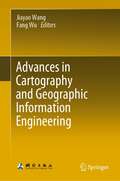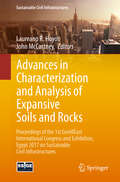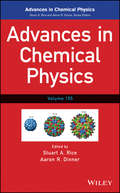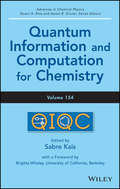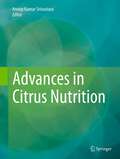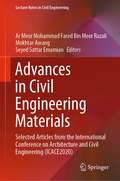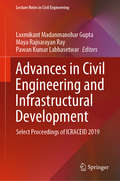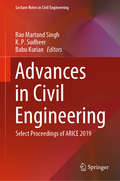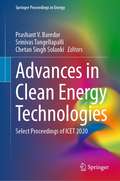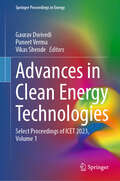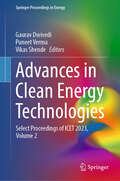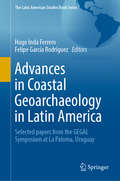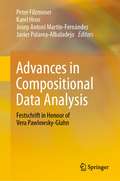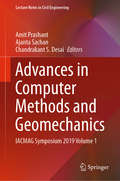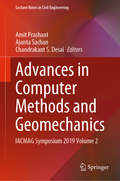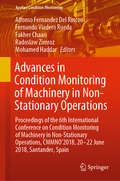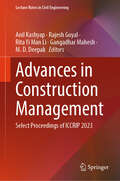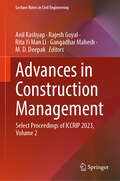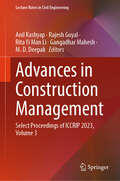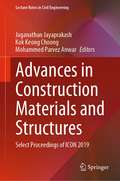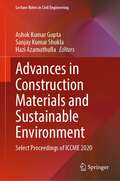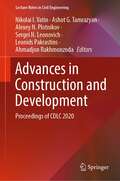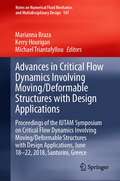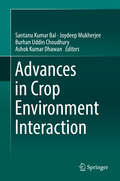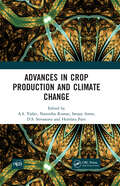- Table View
- List View
Advances in Cartography and Geographic Information Engineering
by Jiayao Wang Fang WuThis book reviews and summarizes the development and achievement in cartography and geographic information engineering in China over the past 60 years after the founding of the People's Republic of China. It comprehensively reflects cartography, as a traditional discipline, has almost the same long history with the world's first culture and has experienced extraordinary and great changes. The book consists of nineteen thematic chapters. Each chapter is in accordance with the unified directory structure, introduction, development process, major study achievements, problem and prospect, representative works, as well as a lot of references. It is useful as a reference both for scientists and technicians who are engaged in teaching, researching and engineering of cartography and geographic information engineering.
Advances in Characterization and Analysis of Expansive Soils and Rocks: Proceedings of the 1st GeoMEast International Congress and Exhibition, Egypt 2017 on Sustainable Civil Infrastructures (Sustainable Civil Infrastructures)
by Laureano R. Hoyos John MccartneyThis volume includes a collection of technical papers covering two important research topics in geotechnical engineering: (1) the behavior and treatment of expansive soils, and (2) the characterization of rock properties. The twelve studies on expansive soils include investigations into novel stabilization techniques for expansive soils using different admixtures or mechanical consolidation techniques, as well as new experimental approaches to evaluate the behavior of expansive soils. They also include an evaluation of wetting boundary conditions on the volume change of expansive soils, as well as the role of hydrologic boundary conditions in arid climates. The four studies on rock properties include thermo-hydro-mechanical behavior of gypsum rock, role of rock strength in blastability, indirect methods to estimate rock strength, and variations in isotope distributions in Permian rocks. The two broad themes in this collection, as summarized above, are representative of local challenges facing geotechnical engineers in the Middle East, but their contributions can also be extended to other regions of the world. This volume is part of the proceedings of the 1st GeoMEast International Congress and Exhibition on Sustainable Civil Infrastructures, Egypt 2017.
Advances in Chemical Physics
by Aaron R. Dinner Stuart A. RiceThe Advances in Chemical Physics series--the cutting edge of research in chemical physicsThe Advances in Chemical Physics series provides the chemical physics and physical chemistry fields with a forum for critical, authoritative evaluations of advances in every area of the discipline. Filled with cutting-edge research reported in a cohesive manner not found elsewhere in the literature, each volume of the Advances in Chemical Physics series offers contributions from internationally renowned chemists and serves as the perfect supplement to any advanced graduate class devoted to the study of chemical physics.This volume explores:Hydrogen Bond Topology and Proton Ordering in Ice and Water Clusters (Sherwin J. Singer and Chris Knight)Molecular Inner-Shell Spectroscopy, Arpis Technique and Its Applications (Eiji Shigemasa and Nobuhiro Kosugi)Geometric Optimal Control of Simple Quantum Systems: Geometric Optimal Control Theory (Dominique Sugny)Density Matrix Equation for a Bathed Small System and its Application to Molecular Magnets (D. A. Garanin)A Fractional Langevin Equation Approach to Diffusion Magnetic Resonance Imaging (Jennie Cooke)
Advances in Chemical Physics, Quantum Information and Computation for Chemistry
by Aaron R. Dinner Stuart A. Rice Sabre Kais Birgitta WhaleyExamines the intersection of quantum information and chemical physicsThe Advances in Chemical Physics series is dedicated to reviewing new and emerging topics as well as the latest developments in traditional areas of study in the field of chemical physics. Each volume features detailed comprehensive analyses coupled with individual points of view that integrate the many disciplines of science that are needed for a full understanding of chemical physics.This volume of the series explores the latest research findings, applications, and new research paths from the quantum information science community. It examines topics in quantum computation and quantum information that are related to or intersect with key topics in chemical physics. The reviews address both what chemistry can contribute to quantum information and what quantum information can contribute to the study of chemical systems, surveying both theoretical and experimental quantum information research within the field of chemical physics.With contributions from an international team of leading experts, Volume 154 offers seventeen detailed reviews, including:Introduction to quantum information and computation for chemistryQuantum computing approach to non-relativistic and relativistic molecular energy calculationsQuantum algorithms for continuous problems and their applicationsPhotonic toolbox for quantum simulationVibrational energy and information transfer through molecular chainsTensor networks for entanglement evolutionReviews published in Advances in Chemical Physics are typically longer than those published in journals, providing the space needed for readers to fully grasp the topic: the fundamentals as well as the latest discoveries, applications, and emerging avenues of research. Extensive cross-referencing enables readers to explore the primary research studies underlying each topic.
Advances in Citrus Nutrition
by Anoop Kumar SrivastavaThis is a solitary attempt to streamline all the possible information related to citrus nutrition, with emphasis on diagnosis and management of nutrient constraints, employing a variety of state-of-art techniques evolved globally over the years . While doing so care has been taken to include peripheral disciplines so that the discussion becomes more lively and authoritative. An entire array of exclusive subjects has been nicely portrayed with the help of latest data and photographs.
Advances in Civil Engineering Materials: Selected Articles from the International Conference on Architecture and Civil Engineering (ICACE2020) (Lecture Notes in Civil Engineering #139)
by Mokhtar Awang Seyed Sattar Emamian Ar Meor Mohammad Fared Bin Meor RazaliThis book presents selected articles from the 4th International Conference on Architecture and Civil Engineering 2020, held in Kuala Lumpur, Malaysia. Written by leading researchers and industry professionals, the papers highlight recent advances and address the current issues in the fields of civil engineering and architecture.
Advances in Civil Engineering and Infrastructural Development: Select Proceedings of ICRACEID 2019 (Lecture Notes in Civil Engineering #87)
by Pawan Kumar Labhasetwar Laxmikant Madanmanohar Gupta Maya Rajnarayan RayThis book comprises selected proceedings of the International Conference on Recent Advancements in Civil Engineering and Infrastructural Developments (ICRACEID 2019). The contents are broadly divided into five areas (i) smart transportation with urban planning, (ii) clean energy and environment, (iii) water distribution and waste management, (iv) smart materials and structures, and (v) disaster management. The book aims to provide solutions to global challenges using innovative and emerging technologies covering various fields of civil engineering. The major topics covered include urban planning, transportation, water distribution, waste management, disaster management, environmental pollution and control, environmental impact assessment, application of GIS and remote sensing, and structural analysis and design. Given the range of topics discussed, the book will be beneficial for students, researchers as well industry professionals.
Advances in Civil Engineering: Select Proceedings of ARICE 2019 (Lecture Notes in Civil Engineering #83)
by Rao Martand Singh K. P. Sudheer Babu KurianThis volume comprises select peer reviewed papers presented at the international conference - Advanced Research and Innovations in Civil Engineering (ARICE 2019). It brings together a wide variety of innovative topics and current developments in various branches of civil engineering. Some of the major topics covered include structural engineering, water resources engineering, transportation engineering, geotechnical engineering, environmental engineering, and remote sensing. The book also looks at emerging topics such as green building technologies, zero-energy buildings, smart materials, and intelligent transportation systems. Given its contents, the book will prove useful to students, researchers, and professionals working in the field of civil engineering.
Advances in Clean Energy Technologies: Select Proceedings of ICET 2020 (Springer Proceedings in Energy)
by Chetan Singh Solanki Prashant V. Baredar Srinivas TangellapalliThis book presents select proceedings of the international conference on Innovations in Clean Energy Technologies (ICET 2020) and examines a range of durable, energy efficient and next-generation smart green technologies for sustainable future by reflecting on the trends, advances and development taking place all across the globe. The topics covered include smart technologies based product, energy efficient systems, solar and wind energy, carbon sequestration, green transportation, green buildings, energy material, biomass energy, smart cites, hydro power, bio-energy and fuel cell. The book also discusses various performance attributes of these clean energy technologies and their workability and carbon footprint. The book will be a valuable reference for beginners, researchers and professionals interested in clean energy technologies.
Advances in Clean Energy Technologies: Select Proceedings of ICET 2023, Volume 1 (Springer Proceedings in Energy)
by Puneet Verma Gaurav Dwivedi Vikas ShendeThis book presents select peer-reviewed proceedings of the International Conference on Innovations in Clean Energy Technologies (ICET 2023) and examines a range of durable, energy-efficient, and next-generation smart green technologies for a sustainable future by reflecting on the trends, advances, and developments taking place across the globe. The topics covered include smart technologies-based products, energy-efficient systems, solar and wind energy, carbon sequestration, green transportation, green buildings, energy material, biomass energy, smart cities, hydropower, bio-energy, and fuel cells. The book also discusses various performance attributes of these clean energy technologies and their workability and carbon footprint. The book is a valuable reference for beginners, researchers, and professionals interested in clean energy technologies.
Advances in Clean Energy Technologies: Select Proceedings of ICET 2023, Volume 2 (Springer Proceedings in Energy)
by Puneet Verma Gaurav Dwivedi Vikas ShendeThis book contains select peer-reviewed proceedings from the International Conference on Innovations in Clean Energy Technologies (ICET 2023). It explores a variety of durable, energy-efficient, and next-generation smart green technologies aimed at promoting a sustainable future. The topics covered include smart technology-based products, energy-efficient systems, solar and wind energy, carbon sequestration, green transportation, green buildings, energy materials, biomass energy, smart cities, hydropower, bio-energy, and fuel cells. The book also discusses the performance attributes of these clean energy technologies, as well as their workability and carbon footprint. It is a valuable reference for beginners, researchers, and professionals interested in clean energy technologies.
Advances in Coastal Geoarchaeology in Latin America: Selected papers from the GEGAL Symposium at La Paloma, Uruguay (The Latin American Studies Book Series)
by Hugo Inda Ferrero Felipe García RodríguezThis book introduces selected contributions from the GEGAL (Spanish acronym for Latin American Geoarchaeological Studies Group) Workshop held at La Paloma Beach, Uruguay, with a focus on Coastal Geoarchaeology, and an attendance of more than 50 researchers, students and professionals from several Latin American countries. The contributions were selected in order to encompass the vast array of environmental, geomorphological and archaeological contexts comprised in the geographical frame of Latin America. Topics covered through the chapters include specific issues such as human occupation and fluvial dynamic processes in mountain and lowland environments, methodological developments in dating methods, taphonomy and chemical proxies, as well as landscape modification by anthropogenic disturbances. As the first compilation of Coastal Geoarchaeology for Latin America, this book is intended to become a useful tool for students, researchers and professionals from related fields, as it comprises not only the regional state of the art, but also new insights and developments which can be potentially applied to other contexts world wide.
Advances in Compositional Data Analysis: Festschrift in Honour of Vera Pawlowsky-Glahn
by Peter Filzmoser Josep Antoni Martín-Fernández Karel Hron Javier Palarea-AlbaladejoThis book presents modern methods and real-world applications of compositional data analysis. It covers a wide variety of topics, ranging from an updated presentation of basic concepts and ideas in compositional data analysis to recent advances in the context of complex data structures. Further, it illustrates real-world applications in numerous scientific disciplines and includes references to the latest software solutions available for compositional data analysis, thus providing a valuable and up-to-date guide for researchers and practitioners working with compositional data. Featuring selected contributions by leading experts in the field, the book is dedicated to Vera Pawlowsky-Glahn on the occasion of her 70th birthday.
Advances in Computer Methods and Geomechanics: IACMAG Symposium 2019 Volume 1 (Lecture Notes in Civil Engineering #55)
by Chandrakant S. Desai Amit Prashant Ajanta SachanThis volume presents selected papers from IACMAG Symposium,The major themes covered in this conference are Earthquake Engineering, Ground Improvement and Constitutive Modelling. This volume will be of interest to researchers and practitioners in geotechnical and geomechanical engineering.
Advances in Computer Methods and Geomechanics: IACMAG Symposium 2019 Volume 2 (Lecture Notes in Civil Engineering #56)
by Chandrakant S. Desai Amit Prashant Ajanta SachanThis volume presents selected papers from IACMAG Symposium,The major themes covered in this conference are Earthquake Engineering, Ground Improvement and Constitutive Modelling. This volume will be of interest to researchers and practitioners in geotechnical and geomechanical engineering.
Advances in Condition Monitoring of Machinery in Non-Stationary Operations: Proceedings of the 6th International Conference on Condition Monitoring of Machinery in Non-Stationary Operations, CMMNO’2018, 20-22 June 2018, Santander, Spain (Applied Condition Monitoring #15)
by Fakher Chaari Mohamed Haddar Radoslaw Zimroz Alfonso Fernandez Del Rincon Fernando Viadero RuedaThis book is aimed at researchers, industry professionals and students interested in the broad ranges of disciplines related to condition monitoring of machinery working in non-stationary conditions. Each chapter, accepted after a rigorous peer-review process, reports on a selected, original piece of work presented and discussed at the International Conference on Condition Monitoring of Machinery in Non-stationary Operations, CMMNO’2018, held on June 20 – 22, 2018, in Santander, Spain. The book describes both theoretical developments and a number of industrial case studies, which cover different topics, such as: noise and vibrations in machinery, conditioning monitoring in non-stationary operations, vibro-acoustic diagnosis of machinery, signal processing, application of pattern recognition and data mining, monitoring and diagnostic systems, faults detection, dynamics of structures and machinery, and mechatronic machinery diagnostics.
Advances in Construction Management: Select Proceedings of ICCRIP 2023 (Lecture Notes in Civil Engineering #238)
by Anil Kashyap Rita Yi Man Li Rajesh Goyal Gangadhar Mahesh M. D. DeepakThis book presents the select proceedings of the 7th International Conference on Construction, Real Estate, Infrastructure, and Project Management (ICCRIP 2023) and explores recent and innovative developments in all aspects of the CRIP sector. The book covers various issues in construction management, advancements in construction technologies and materials, sustainable construction practices, managerial issues in the CRIP sector, construction 4.0, project management, real estate and urban planning, energy, environment and sustainability. The book will be useful for researchers and professionals involved in construction management, civil engineering and related fields.
Advances in Construction Management: Select Proceedings of ICCRIP 2023, Volume 2 (Lecture Notes in Civil Engineering #601)
by Anil Kashyap Rita Yi Man Li Rajesh Goyal Gangadhar Mahesh M. D. DeepakThis book presents the select proceedings of the 7th International Conference on Construction, Real Estate, Infrastructure, and Project Management (ICCRIP 2023) and explores recent and innovative developments in all aspects of the CRIP sector. The book covers various issues in construction management, advancements in construction technologies and materials, sustainable construction practices, managerial issues in the CRIP sector, construction 4.0, project management, real estate and urban planning, energy, environment and sustainability. The book will be useful for researchers and professionals involved in construction management, civil engineering and related fields.
Advances in Construction Management: Select Proceedings of ICCRIP 2023, Volume 3 (Lecture Notes in Civil Engineering #618)
by Anil Kashyap Rita Yi Man Li Rajesh Goyal Gangadhar Mahesh M. D. DeepakThis book presents the select proceedings of the 7th International Conference on Construction, Real Estate, Infrastructure, and Project Management (ICCRIP 2023) and explores recent and innovative developments in all aspects of the CRIP sector. The book covers various issues in construction management, advancements in construction technologies and materials, sustainable construction practices, managerial issues in the CRIP sector, construction 4.0, project management, real estate and urban planning, energy, environment and sustainability. The book will be useful for researchers and professionals involved in construction management, civil engineering and related fields.
Advances in Construction Materials and Structures: Select Proceedings of ICON 2019 (Lecture Notes in Civil Engineering #111)
by Kok Keong Choong Jaganathan Jayaprakash Mohammed Parvez AnwarThis book comprises select and peer-reviewed proceedings of the International Conference on Recent Trends in Construction Materials and Structures (ICON 2019). The contents cover various latest developments and emerging technologies in sustainable construction materials, utilization of waste materials in concrete, special concrete, maintenance of heritage structures, earthquake engineering, and structural dynamics. The book also provides effective and feasible solutions to current problems in sustainable construction materials and structures. This book is useful for students, researchers, and industry professionals interested in concrete technology and structures.
Advances in Construction Materials and Sustainable Environment: Select Proceedings of ICCME 2020 (Lecture Notes in Civil Engineering #196)
by Sanjay Kumar Shukla Ashok Kumar Gupta Hazi AzamathullaThis book comprises select papers presented at the International Conference on Construction Materials and Environment (ICCME 2020). The topics discussed revolve around the identification and utilization of novel construction materials primarily in the areas of structural engineering, geotechnical engineering, transportation engineering, and environmental engineering. The volume presents a compilation of thoroughly studied and utilized sustainable construction materials in different areas of civil engineering. Newly developed testing methodologies, physical modelling methods, numerical studies, and other latest techniques discussed in this book can prove to be useful for researchers and practitioners across the globe.
Advances in Construction and Development: Proceedings of CDLC 2020 (Lecture Notes in Civil Engineering #197)
by Nikolai I. Vatin Ashot G. Tamrazyan Alexey N. Plotnikov Sergei N. Leonovich Leonids Pakrastins Ahmadjon RakhmonzodaThis book contains the materials of the Conference "Construction and Development: Life Cycle-2020" (CDLC-2020), held at Chuvash State University, Russia. The content of this volume is devoted to improving methods for calculating building structures, strengthening them and assessing their suitability for use, monitoring buildings, improving building technologies, geotechnics, energy efficiency of building envelopes and energy systems, introducing new structures and materials, and economic assessment of construction. It also consists of test data for load-bearing building structures. This volume will prove to be a valuable resource for those in academia and industry.
Advances in Critical Flow Dynamics Involving Moving/Deformable Structures with Design Applications: Proceedings of the IUTAM Symposium on Critical Flow Dynamics involving Moving/Deformable Structures with Design applications, June 18-22, 2018, Santorini, Greece (Notes on Numerical Fluid Mechanics and Multidisciplinary Design #147)
by Marianna Braza Kerry Hourigan Michael TriantafyllouThis book reports on the latest knowledge concerning critical phenomena arising in fluid-structure interaction due to movement and/or deformation of bodies. The focus of the book is on reporting progress in understanding turbulence and flow control to improve aerodynamic / hydrodynamic performance by reducing drag, increasing lift or thrust and reducing noise under critical conditions that may result in massive separation, strong vortex dynamics, amplification of harmful instabilities (flutter, buffet), and flow -induced vibrations. Theory together with large-scale simulations and experiments have revealed new features of turbulent flow in the boundary layer over bodies and in thin shear layers immediately downstream of separation. New insights into turbulent flow interacting with actively deformable structures, leading to new ways of adapting and controlling the body shape and vibrations to respond to these critical conditions, are investigated. The book covers new features of turbulent flows in boundary layers over wings and in shear layers immediately downstream: studies of natural and artificially generated fluctuations; reduction of noise and drag; and electromechanical conversion topics. Smart actuators as well as how smart designs lead to considerable benefits compared with conventional methods are also extensively discussed. Based on contributions presented at the IUTAM Symposium “Critical Flow Dynamics involving Moving/Deformable Structures with Design applications”, held in June 18-22, 2018, in Santorini, Greece, the book provides readers with extensive information about current theories, methods and challenges in flow and turbulence control, and practical knowledge about how to use this information together with smart and bio-inspired design tools to improve aerodynamic and hydrodynamic design and safety.
Advances in Crop Environment Interaction
by Joydeep Mukherjee Santanu Kumar Bal Burhan Uddin Choudhury Ashok Kumar Dhawan<p>Agriculture is currently facing multi-faceted threats in the form of unpredictable weather variability, frequent droughts and scarcity of irrigation water, together with the degradation of soil resources and declining environmental health. These stresses result in the modification of plant physiology to impart greater resilience to changing abiotic and biotic environments, but only at the cost of declining plant productivity. In light of these facts, assessing the status of natural resource bases, and understanding the mechanisms of soil-plant-environment interactions so as to devise adaptation and mitigation approaches, represent great and imminent challenges for all of us. In this context, it is essential to understand the potential applications of modern tools, existing coping mechanisms and their integration, as this will allow us to develop suitable advanced mitigation strategies. <p>From a broader perspective, the book deals with crop-environment interaction in the context of changing climatic conditions. To do so, it addresses four major aspects: <p> <li>Understanding the mechanism of carbon dynamics in the soil-plant-environment continuum; greenhouse gas fluxes in agricultural systems; and soil properties influenced by climate change and carbon sequestration processes. <li>Mitigation and management of the photo-thermal environment to improve crop productivity; soil health under variable climate; reducing agro-ecosystem evapotranspiration losses through biophysical controls; and heat stress in field crops and its management. <li>Studying the impact of climate change on biotic environments; insect-pest interactions; manifestations of disease; and adaptation strategies for island agro-ecosystems. <li>Innovative approaches to assess stress impacts in crops, such as crop modeling, remote sensing, spectral stress indices etc.</li> <p> <p>The book presents a collection of contributions from authoritative experts in their respective fields. Offering young researchers new perspectives and future research directions, it represents a valuable guide for graduate students and academics alike.</p>
Advances in Crop Production and Climate Change
by Narendra Kumar Sanjay Arora A. S. Yadav D. S. Srivastava Hemlata PantThis book has comprehensive coverage and advances in agriculture for sustainable development and is expected to provide valuable sources for scholars and researchers, as well as serve as a guide book to the farmer’s community and development agencies. The book is organized into 18 chapters, which include advances in production technologies of crops e.g. rice, wheat, barley, maize, pearl millet, pulses and oilseeds; sugarcane; medicinal and aromatic plants; vegetable crops; fodder crops; resource conservation technologies; management of degraded and sodic lands; soil biodiversity; farm mechanization, etc. The text is illustrated with tables, figures and photographs to bring out the significant findings. The book provides cutting-edge scientific knowledge as well as solid background information that are accessible for those who have a strong interest in agricultural research and development and want to learn more on the challenges facing the global agricultural production systems.Note: T&F does not sell or distribute the Hardback in India, Pakistan, Nepal, Bhutan, Bangladesh and Sri Lanka. This title is co-published with New India Publishing Agency.
